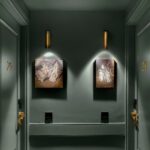Table of Contents
ToggleThe Legacy of Simone de Beauvoir at Maison Colbert
A delicate aroma of cherry blossom permeates Maison Colbert, a luxury hotel located in a historic 17th-century residence in Paris. The lush garden and charming outdoor seating create a welcoming atmosphere for guests enjoying afternoon tea, making it feel like spring year-round, even when rain falls heavily outside. This beautiful hotel, recently transformed by the Meliá Collection, also honors its most distinguished resident, the acclaimed author and philosopher Simone de Beauvoir, who lived here over seventy years ago.
Simone de Beauvoir's presence resonates within the hotel, especially through her groundbreaking 1949 work, The Second Sex. The hotel's walls are adorned with calming pastel and turquoise hues, combined with modern and mid-century furniture. It was in this very location, specifically the top floor that now hosts the grandest suite, where de Beauvoir penned her revolutionary thoughts, encapsulated in her declaration: “One is not born, but rather becomes, a woman.” This monumental text, reflecting the existentialism of the time, controversies, and her feminist advocacy, was initially published by Gallimard.
A Historical Perspective on the Latin Quarter
The Second Sex also served as a beacon of hope for post-World War II France. De Beauvoir observed the societal changes from her apartment on 7 Rue de l'Hôtel Colbert, situated in the heart of the enchanting Latin Quarter. This area, drenched in academic and artistic history, was once populated by Latin-speaking scholars from the nearby Sorbonne and continues to inspire creativity. Today, it offers stunning views of Notre Dame Cathedral, which recently reopened after a devastating fire in 2019.
The Latin Quarter, known for its intellectual vibrancy, has been a sanctuary for numerous writers and poets. One such refuge is the iconic Shakespeare and Company bookstore at 37 Rue de la Bûcherie, which has welcomed literary figures like Ernest Hemingway since it opened in 1951.
The Architectural Charm of Maison Colbert
Named after Jean Baptiste Colbert, the finance minister of Louis XIV, Maison Colbert was built in 1637 and retains its original Neoclassical architecture. Although Colbert was never its owner, the house served as a cultural hub, including housing the Turgenev Russian Library in 1938. Following World War II, the building's façade and roof were designated as part of Paris' historical heritage during the restoration efforts led by architects Álvaro and Adriana Sans.
This renovation was inspired by the Impressionist movement—particularly the work of Spanish painter Joaquín Sorolla. The hotel's design incorporates seven colors that reflect Sorolla's art, creating a bright and joyful atmosphere. Reproductions of his works grace the hotel's walls, establishing a connection to the vibrant artistic history of Paris.
Distinctive Suites and Culinary Offerings
The luxurious María Sorolla suite pays homage to Sorolla's mother and features the room where de Beauvoir wrote her acclaimed novel The Mandarins (1954). This suite blends literary history with artistic influence, further enriched by artwork showcasing Sorolla's muse, Clotilde García del Castillo, whose image can be found throughout the hotel.
The hotel's restaurant, Café Clotilde, named after Sorolla's muse, is operated by the celebrated pastry chef Nina Métayer, hailed as the world's best pastry chef in 2024. With a menu that emphasizes classic French pastries, it serves as a delightful ending to a day filled with experiences, such as private Seine cruises, wine tastings in a historic wine cellar, and excursions to Paris' top monuments in vintage vehicles.
Maison Colbert seamlessly weaves together history, art, and elegant hospitality, ensuring that the spirit of Paris continues to inspire generations of artists and thinkers.










